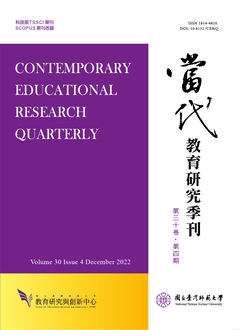

本行動研究報導一位大學英文教師在寫作教學的改進過程。最初的教學包含四次指定題目的寫作與修改練習,教師已疲於批改,但仍欠缺藉由寫作以訓練批判思考與獨立發聲的重要元素。為求改進,教師安排自選題作文,加入多階段多來源的形成性評量與回饋設計,示範進而導引學生在構思過程中相互評量與批判,並安排期末的成果發表儀式。過程中,任課教師不再是唯一的評量者與意見回饋來源,而是將文章的發展從訂定主題、大綱、細部論點、草稿、修改到校對分成六個階段,並在每個階段安排兩種不同人員提供回饋,如助教及同儕。這些回饋意見包含了批評與挑戰,協助寫作學習者在文章發展過程中改進。最終產出的小論文成品以批判思考力評量表檢驗,結果顯示,學生多能選擇切身議題、表達個人意見,且對批判思考的結構有所掌握,唯在批判思考的內容論證上仍有改進空間。
This action research reports how a college English teacher improved heressay writing instruction. The original course design consisted of instructionand four rounds of drafting and revising under assigned topics. While theteacher had been busy enough giving individual feedback, an importantelement of cultivating critical thinking and giving learners a voice was absentfrom the course. To address the problem, the teacher required learners to writean additional essay on a topic they each chose, designed an assessmentscheme with multi-stage and multi-source feedback, and celebrated the finalproducts at the end of the semester. During the process, the teacher was nolonger the only feedback provider. Instead, essay development was arrangedinto six stages including idea generation, general outline, detailed outline,drafting, editing and proofreading. For each stage, feedback came from twodifferent sources, such as the teaching assistant and peers. The feedbackconsisted of questions and challenges and helped the author learners improvefrom one stage to the next. The resultant essays were examined against acritical thinking rubric. Analysis indicated that these essays demonstratedunique personal opinions and that the writers had control over the structure ofcritical thinking. But in terms of the soundness of reasoning, there was moreroom for improvement.

本著作係採用創用 CC 姓名標示-非商業性 3.0 台灣 授權條款授權.
本刊國立台灣師範大學教育研究與創新中心
106台北市和平東路一段162號 | 電話: 02-7749-3670 | E-mail: cerecerq@gmail.com
教創中心 | 師大 | 電子報 | 線上投審系統
本刊由國家科學及技術委員會人文社會科學研究中心補助經費
© 2014 CERI-NTNU
